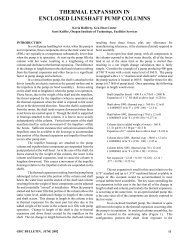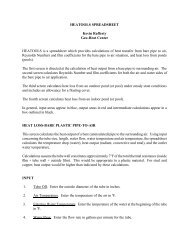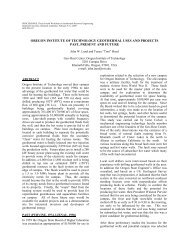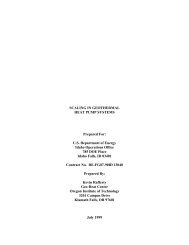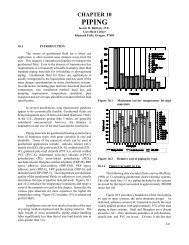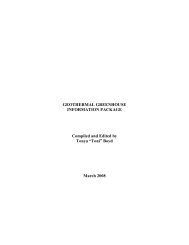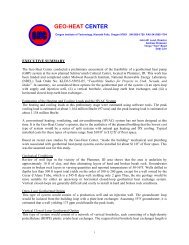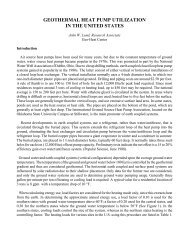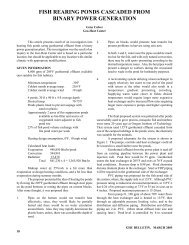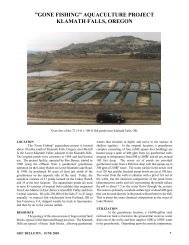Companion Study Guide on Short Course on Geothermal ... - OSTI
Companion Study Guide on Short Course on Geothermal ... - OSTI
Companion Study Guide on Short Course on Geothermal ... - OSTI
You also want an ePaper? Increase the reach of your titles
YUMPU automatically turns print PDFs into web optimized ePapers that Google loves.
4.2 Corrosi<strong>on</strong> Engineering and Design<br />
The design of the geothermal system is as critical in c<strong>on</strong>trolling corrosi<strong>on</strong> as the selecti<strong>on</strong> of<br />
suitable materials. Furthermore, the design/material selecti<strong>on</strong> process is interactive in that certain<br />
design decisi<strong>on</strong>s force the use of certain materials; while, selecti<strong>on</strong> of materials may dictate design.<br />
In all cases, the objective should be the same: to produce an adequately reliable system with the<br />
lowest possible life-time cost.<br />
Three basic corrosi<strong>on</strong> engineering design philosophies for geothermal systems are apparent:<br />
1. Use corrosi<strong>on</strong> resistant materials throughout the system,<br />
2. Exclude or remove oxygen and use carb<strong>on</strong> steel throughout the system.<br />
3. Transfer the enthalpy via an isolati<strong>on</strong> heat exchanger to a n<strong>on</strong>-corrosive working<br />
medium so that the kind and number of comp<strong>on</strong>ents c<strong>on</strong>tacting the geothermal fluid<br />
are minimized, and make those comp<strong>on</strong>ents of corrosi<strong>on</strong> resistant materials.<br />
The first philosophy would produce a very reliable system requiring little maintenance.<br />
However, the cost would be very high, and at least in the United States, many of the desired<br />
comp<strong>on</strong>ents are not available in the required alloys.<br />
The sec<strong>on</strong>d philosophy may be c<strong>on</strong>sidered for district-sized heating projects with attendant<br />
surface storage and potential for oxygen intrusi<strong>on</strong>, because it may be ec<strong>on</strong>omical to inhibit the<br />
geothermal fluid by c<strong>on</strong>tinuous additi<strong>on</strong> of excess sulfite as an oxygen scavenger. When this is d<strong>on</strong>e,<br />
carb<strong>on</strong> steel can be used for heat exchange equipment, provided fluid pH is greater than 8. This<br />
sec<strong>on</strong>d philosophy is widely and successfully used for municipal heating systems in Iceland. If this<br />
approach is used, system design should minimize the introducti<strong>on</strong> of oxygen to reduce sulfite costs.<br />
Use of vented tanks should be minimized.<br />
The sec<strong>on</strong>d philosophy has three major drawbacks. First, the sulfite additi<strong>on</strong> plant is relatively<br />
complex and requires careful maintenance and operati<strong>on</strong>. Sec<strong>on</strong>d, failure of the sulfite additi<strong>on</strong> plant,<br />
or insufficient treatment, is likely to cause rapid failure of the carb<strong>on</strong> steel heat exchangers. Third,<br />
sulfite additi<strong>on</strong> will probably not be ec<strong>on</strong>omical for smaller systems because of the first point above.<br />
Without oxygen scavenging, and even with careful design, some oxygen c<strong>on</strong>taminati<strong>on</strong> will occur and<br />
carb<strong>on</strong> steel heat exchangers will probably not be satisfactory.<br />
The third philosophy, transferring the enthalpy via isolati<strong>on</strong> heat exchangers to a n<strong>on</strong>corrosive<br />
sec<strong>on</strong>dary heat transfer medium and minimizing the kind and number of comp<strong>on</strong>ents<br />
exposed to the geothermal fluids, has several advantages for systems of all sizes. The resultant<br />
system is much simpler to operate, and therefore, more reliable than above. Only a small number of<br />
geothermal resistant comp<strong>on</strong>ents are required and it is feasible to deign systems in which oxygen<br />
exclusi<strong>on</strong> is not critical. Retrofitting of existing fossil-fired hot water is also simplified since the<br />
isolati<strong>on</strong> heat exchanger may either entirely replace the existing heater, or be located in-line with the<br />
water supply to the existing heater. Finally, even with careful material selecti<strong>on</strong> and design,



